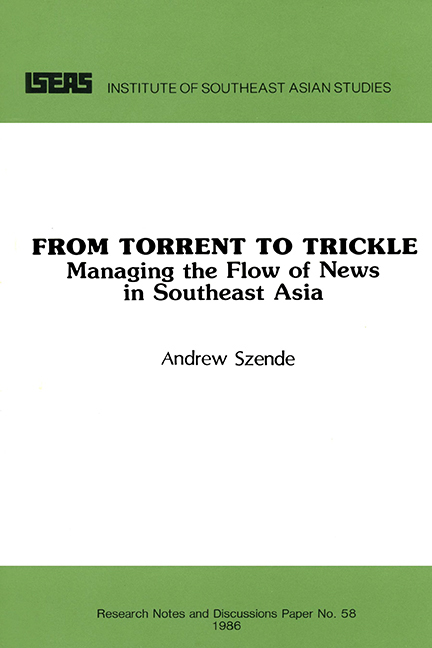II - Methodology
from PART 1 - INTRODUCTION
Published online by Cambridge University Press: 21 October 2015
Summary
The study was designed to examine five aspects of ASEAN perceptions of the flow of news in the region: what are considered to be useful sources of news, how the professional news practitioners in the region feel about the quality of reporting of the region in the rest of the world, how these same professionals feel about the quality of reporting of the outside world in the region, what are some of their perceptions of news coverage of individual ASEAN countries in the news media of other ASEAN countries, and, how the news exchanges within the ASEAN region function.
The basic technique for the research was personal interviews, conducted while the author was living in Singapore in 1982 and 1983. In the other four ASEAN capitals he conducted his interviews during one-week field trips spread over a four-month period, between mid-November 1982 and mid-March 1983. The style of the interviews was deliberately passive, in order to allow respondents maximum opportunity to give their views, without being challenged or confronted, and to avoid putting them in a defensive position. The aim was to ascertain their personal and professional perceptions about the flow of news in the region in order to gain a genuine understanding of the feelings of ASEAN respondents. The interviews usually lasted about two hours. Most of them were tape recorded, although it was agreed that respondents would not be quoted by name, except in cases where they gave special permission or where they referred to statements already in the public domain. Quotations are from transcripts of interviews or from public statements.
In most cases, the interviews followed the same pattern, set by a questionnaire based on the relevant literature of the news flow debate and the author's own experience as a journalist. For example, one section of the questionnaire, dealing with the various categories of news, is an adaptation of the categories devised by Wilbur Schramm and Erwin Atwood while the survey on sources of news springs from the author's own experience.
- Type
- Chapter
- Information
- From Torrent to TrickleManaging the Flow of News in Southeast Asia, pp. 14 - 21Publisher: ISEAS–Yusof Ishak InstitutePrint publication year: 1986



